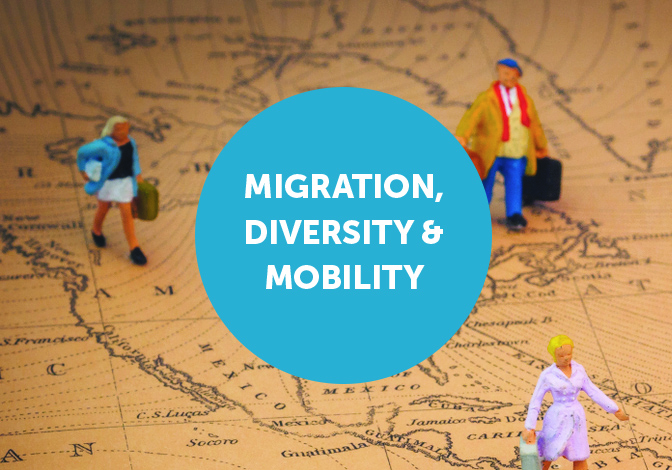


Is There Such a Thing as “Anti-White Racism”?
16 November 2020
When Constitutional Law Imagines Foreigners
16 November 2020A Brief Overview of the State of the Art
by Hélène Thiollet et Florian Oswald

© Shutterstock
Labour economics classically predicts that wages are determined by supply and demand. Theoretically, if demand remains constant, emigration should increase wages in countries of origin (decreasing labour supply) and decrease wages in receiving countries (increasing labour supply). A malthusian vision of the economy also assumes that the arrival of new-comers in a market of limited jobs will leave some workers without employment or drive previously employed ones out of their jobs. The view that immigration decreases natives’ wages and generates unemployment are widely held. An alternative theory suggests that immigrants also consume in the destination country, hence increasing local demand, and/or that local production expands, now that additional labor is available. We need to try and empirically distinguish the competing theories from each other. We also need to examine if this is what is happening on empirical grounds at local levels?
Causality is Difficult to Establish
Some studies show that the wage curve corresponds to what is implied by the first type of theory: immigration will decrease wages by 3 to 4 % for a 10% increase in workers in a given skill-experience group(1)George J. Borjas, “The Labor Demand Curve is Downward Sloping: Reexamining the Impact of Immigration on the Labor Market“, The Quarterly Journal of Economics, November 2003..
But economists find it difficult to identify the impact of migration on wages or unemployment, both in countries of origins and in host countries. Why? Causal relations are hard to establish because migrants often move to receiving countries when labour market conditions are good and improving there. Thus, observing that wages do not decrease when migrants arrive may both mean that they are not impacted by migration, or that wage increase due to better labour market conditions compensate the impact. The same applies to unemployment: context matters and market dynamics strongly determine the impact of immigration or emigration.

CC0 Public Domain / pixy.org
Apart from problems to establish a causal relationship, migration effects are also specific to time and place, to economic conditions and dynamics in host and receiving countries. Thus results will vary according to the type of data (e.g. micro vs macro) used, the scale (city, national, inter-national), the theoretical model assumed, and the timeframe (which years, and short- vs long run) considered.
Empirical evidence in OECD countries has recently shown that the overall effect of immigration is either neutral or slightly positive on average natives’ wages and has no overall impact on natives’ employment. But these results need refining: when looking at differential impact along the remuneration distribution, negative effects for low skilled workers and positive effects for highly skilled workers are observed, and any declines in the wages and employment in the short run is compensated by rising wages and employment in the long run.
The Impact Differs According to Employment Levels
The UK example (1983-2000) shows that immigration had no statistically significant effect on the overall employment outcomes of UK-born workers(2)Christian Dustmann, Tommaso Frattini and Ian Preston, “The Effect of Immigration along the Distribution of Wages“, Review of Economic Studies, 2013..
It also shows that wages of poorer native workers decrease (the 20th percentile of the distribution) whereas wages of the richer native workers grow (above the 40th percentile) when immigrants arrive. This echoes an important dimension of immigration: the fact that migrants downgrade considerably upon arrival (both in wages and level of employment) and that their location in the wage distribution (crowding the bottom) is generally below their actual skill level. Empirical evidence shows that this initial mismatch explains the wage impact. Similar studies carried out in the UK after the 2008 crisis confirm the lack of any impact of migration on natives’ unemployment in aggregate during the 2008 economic crisis(3)Paolo Lucchino, Chiara Rosazza Bondibene and Jonathan Portes,”Examining the relationship between immigration and unemployment using National Insurance Number registration data“, NIESR Discussion Paper..

Photo by Olumide Bamgbelu , Unsplash
Further empirical case studies support the idea that fully opening the border to immigration from neighbouring countries increased immigrants to Switzerland only by 4% of the labour force over 8 years (4)Andreas Beerli & Giovanni Peri, 2015, “The Labor Market Effects of Opening the Border: Evidence from Switzerland,” NBER Working Papers.. Such an increased inflow did not have significant aggregate effects but generated differentiated effects across the wage ladder: highly educated workers benefited through higher wages, while middle-educated ones experienced employment losses.
A US based study showed that in the period from 1990 to 2006 immigration had a small effect on the wages of native workers with no high school degree (between 0.6% and +1.7%). It also had a small positive effect on average native wages (+0.6%) and a substantial negative effect (−6.7%) on wages of previous immigrants in the long run(5)Ottaviano, Gianmarco I. P., and Giovanni Peri. 2012. “Rethinking the Effect of Immigration on Wages”Journal of the European Economic Association 10..
Studies Have Contradictory Results
Recent controversies have questioned the existing consensus that the impact of immigration on average native-born workers is small. Classical historical studies(6)Historical episodes that served as “natural experiment” for those immigration chocs are the Mariel boatlift in Miami in 1980 (Card, 1990), repatriated workers from Algeria to France after 1962 (Hunt, 1992), post-soviet Jews to Israel between 1990 and 1994 (Friedberg, 2001), Balkan refugees to 18 EU countries in the 1990s (Angrist & Kugler, 2003 using city-based data had used mass sudden inflows of refugees to establish that immigration does not decrease wages (Card, 1990; (7)“The Impact of Mass Migration on the Israeli Labor Market“, Rachel M. Friedberg, The Quarterly Journal of Economics, nov. 2001. but may slightly increase unemployment (8)Joshua D. Angrist and Adriana D. Kugler, “Protective or Counter-Productive? Labour Market Institutions and the Effect of Immigration on EU Natives“, The Economic Journal, Jun., 2003; Hunt, Jennifer. 1992. “The Impact of the 1962 Repatriates from Algeria on the French Labor Market.” Industrial and Labor Relations Review 45. A study (9)George J. Borjas and Joan Monras, 2016. “The Labor Market Consequences of Refugee Supply Shocks“, Working Papers, CEMFI. confirmed the distributional effect of refuge inflows on wages (negative on low wages and positive on high wages).
But other influential contributions(10)Borjas, George J. 2003. “The Labor Demand Curve Is Downward Sloping: Reexamining the Impact of Immigration on the Labor Market.” The Quarterly Journal of Economics 118 ; Borjas, George J. 2017. “The Wage Impact of the Marielitos : A Reappraisal.” ILR Review. have found a significant negative effect of immigration on the wages of low skilled natives in the U.S. Another study across OECD countries suggested the contrary: no impact of immigration on the wages of low skilled workers since the 1990s but negative impact of emigration from OECD countries(11)Frédéric Docquier & Çağlar Ozden & Giovanni Peri, 2014. “The Labour Market Effects of Immigration and Emigration in OECD Countries,” Economic Journal, Royal Economic Society.. Significances of wage drops or increases were contested in both cases(12)Clemens, Michael, and Jennifer Hunt. 2017. “The Labor Market Effects of Refugee Waves: Reconciling Conflicting Results.” w23433. Cambridge, MA: National Bureau of Economic Research..
What Needs to be Considered
Understanding the mechanisms that are beneficial for labour markets, for natives and migrants, understanding how much and more crucially for how long labour markets are affected in the host countries, requires more than the simpler question “does immigration decrease natives’ wages”. It takes further insight into labour market mechanisms such as:
- Complementarity between natives vs immigrants(13)Card, David. 1990. “The Impact of the Mariel Boatlift on the Miami Labor Market” Industrial and Labor Relations Review 43 (2): 245–57.. As demonstrated by empirical evidence in California from the 1960s onwards, because immigrants are imperfect substitutes for natives with similar education and age, they tend to stimulate, rather than harm, the demand and wages of most US native workers(14)Peri, Giovanni. 2007. “Immigrants’ Complementarities and Native Wages: Evidence from California.” w12956. Cambridge, MA: National Bureau of Economic Research..
- Internal mobility (geographical and professional) of workers both migrants and natives adapting to labour demands (within countries and at a regional scale for the Schengen space). Findings in the United States which could be transferred to the EU Schengen zone or ECOWAS in West Africa suggests that except for a reduced number of native workers, most wage effects resulting from more migration are probably dissipated quite fast (15)Monras, Joan. 2018. “Immigration and Wage Dynamics: Evidence from the Mexican Peso Crisis.” CEPR Discussion Paper 13394..
To sum it up, the evidence from refugee waves shows negative short-term effects on some native workers’ wages and employment in some times and places but no effect in others, and does not support claims of large overall negative effect even on low skilled workers.
Hélène Thiollet, CNRS researcher at the Center for Internanational Studies examines migration policies in developing countries. She is particularly interested in the Middle East and sub-Saharan Africa. See her publications Florian Oswald is an Assistant Professor at the Deparment of Economics. His work is in the fields of Housing, Urban, Macro and Labor Economics. He also like to think about computational techniques required for structural estimation of microeconometric models.s. See his publications.
Notes
| ↑1 | George J. Borjas, “The Labor Demand Curve is Downward Sloping: Reexamining the Impact of Immigration on the Labor Market“, The Quarterly Journal of Economics, November 2003. |
|---|---|
| ↑2 | Christian Dustmann, Tommaso Frattini and Ian Preston, “The Effect of Immigration along the Distribution of Wages“, Review of Economic Studies, 2013. |
| ↑3 | Paolo Lucchino, Chiara Rosazza Bondibene and Jonathan Portes,”Examining the relationship between immigration and unemployment using National Insurance Number registration data“, NIESR Discussion Paper. |
| ↑4 | Andreas Beerli & Giovanni Peri, 2015, “The Labor Market Effects of Opening the Border: Evidence from Switzerland,” NBER Working Papers. |
| ↑5 | Ottaviano, Gianmarco I. P., and Giovanni Peri. 2012. “Rethinking the Effect of Immigration on Wages”Journal of the European Economic Association 10. |
| ↑6 | Historical episodes that served as “natural experiment” for those immigration chocs are the Mariel boatlift in Miami in 1980 (Card, 1990), repatriated workers from Algeria to France after 1962 (Hunt, 1992), post-soviet Jews to Israel between 1990 and 1994 (Friedberg, 2001), Balkan refugees to 18 EU countries in the 1990s (Angrist & Kugler, 2003 |
| ↑7 | “The Impact of Mass Migration on the Israeli Labor Market“, Rachel M. Friedberg, The Quarterly Journal of Economics, nov. 2001. |
| ↑8 | Joshua D. Angrist and Adriana D. Kugler, “Protective or Counter-Productive? Labour Market Institutions and the Effect of Immigration on EU Natives“, The Economic Journal, Jun., 2003; Hunt, Jennifer. 1992. “The Impact of the 1962 Repatriates from Algeria on the French Labor Market.” Industrial and Labor Relations Review 45 |
| ↑9 | George J. Borjas and Joan Monras, 2016. “The Labor Market Consequences of Refugee Supply Shocks“, Working Papers, CEMFI. |
| ↑10 | Borjas, George J. 2003. “The Labor Demand Curve Is Downward Sloping: Reexamining the Impact of Immigration on the Labor Market.” The Quarterly Journal of Economics 118 ; Borjas, George J. 2017. “The Wage Impact of the Marielitos : A Reappraisal.” ILR Review. |
| ↑11 | Frédéric Docquier & Çağlar Ozden & Giovanni Peri, 2014. “The Labour Market Effects of Immigration and Emigration in OECD Countries,” Economic Journal, Royal Economic Society. |
| ↑12 | Clemens, Michael, and Jennifer Hunt. 2017. “The Labor Market Effects of Refugee Waves: Reconciling Conflicting Results.” w23433. Cambridge, MA: National Bureau of Economic Research. |
| ↑13 | Card, David. 1990. “The Impact of the Mariel Boatlift on the Miami Labor Market” Industrial and Labor Relations Review 43 (2): 245–57. |
| ↑14 | Peri, Giovanni. 2007. “Immigrants’ Complementarities and Native Wages: Evidence from California.” w12956. Cambridge, MA: National Bureau of Economic Research. |
| ↑15 | Monras, Joan. 2018. “Immigration and Wage Dynamics: Evidence from the Mexican Peso Crisis.” CEPR Discussion Paper 13394. |




